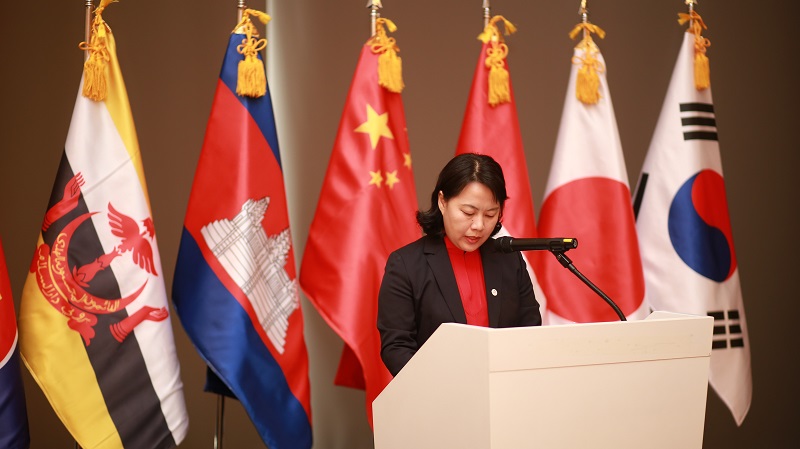
AMRO Director Dr Junhong Chang delivers the opening remarks at the 2018 ASEAN+3 Financial Forum.
December 12, 2018 | Busan, Korea
(As prepared for delivery)
Dear ASEAN+3 Finance and Central Bank Deputies,
Co-chairs of 2018,
Distinguished guests,
Ladies and gentlemen – Good morning.
1. I am honored to welcome you to AMRO’s ASEAN+3 Financial Forum, or ATFF, held back to back with the ASEAN+3 Finance and Central Bank Deputies’ Meeting here in Busan. Today’s event marks the third year running of the ATFF, which provides a regular platform for ASEAN+3 Deputies, academics and high-level representatives from international financial institutions and other multilateral organisations to exchange views on pertinent global and regional issues. Since our inaugural ATFF in Guiyang, China in 2016, the discussions have been lively and thought provoking. Encouraged by this positive development, we have decided to turn this ATFF into a full day event. Once again, I wish to welcome all of you, especially to our guests joining us for the very first time.
2. The global economy is presently at a cross-road, clouded by uncertainties around the international trading regime and tightening financial conditions, led by U.S. monetary policy normalization. Global economic momentum, although still strong, is showing some signs of moderation amid emerging downside risks. Financial markets have turned more volatile, as prospects of higher borrowing costs and weakening fundamentals have seen investors pulling back from emerging markets, including in the region. Threats of further tariffs amid escalating global trade conflicts have further unsettled markets. It is indeed a testing time for policymakers. This is aptly captured by the theme of this year’s ATFF, which is “Voyage in Growing Uncertainties.”
3. Let me share with you some thoughts on these issues.
4. First, on the global economy. The synchronous character of the global expansion has been largely sustained this year, driven by the strengthening of global capex and the tech upcycle. Amongst major G3 economies (U.S., Eurozone and Japan), the U.S. is clearly the strongest, boosted in part by a large fiscal stimulus package. The confluence of these favorable external demand drivers have helped to support global trade, which has in turn benefited the region. Estimates by AMRO showed that exports have contributed 30 to 45 percent share of the region’s growth in 2018. Looking ahead in 2019 however, the picture is less rosy.
5. This brings me to my second point, on the outlook of the U.S. economy. As we know, the current economic expansion in the U.S. is one of the longest on record. This has led to important questions, which are when the downturn will come and how we can prepare for it. This concern, which has been exacerbated by the heightened trade tension with China, is partly responsible for the recent selloff in Wall Street and around the world.
6. Third, on the near term regional outlook. The ASEAN+3 region has been doing well, and remains the fastest growing region in the world. Most economies are growing at close to, or slightly above potential with benign inflation. However, the near term outlook is clouded by growing uncertainties over the future of the global trading system. ASEAN+3 economies are amongst the most open, and have over the past two decades, benefited from growing global and regional trade integration. Any setbacks to the rules-based international trade regime will have negative effects on regional value chains, business confidence, and prospects for future investment in the region.
7. Looking at the region’s long term fundamentals, they remain intact. The favorable outlook is buttressed by mutually reinforcing fundamentals, such as growing middle class, rapid urbanisation and adoption of digital technology, as well as improved macroeconomic management, amongst others. Considering that the global trade conflict is likely to be persistent, to what extent it will alter regional supply chains and investment decision? Is the region better position to deal with the short term ramifications, while taking advantage of the longer term opportunities?
8. In addition to the external challenges, let us not forget the structural forces that are shaping the future of our economies that also underlie our theme today. One key emerging trend is the proliferation of digital technology and automation, which is not only pervasive and deepening, but also creates much anxiety. The digital transformation is already leading to important sectoral shifts in GDP and disruptive change in employment patterns. The digital era also brings the risks of cyber-attacks, which should not be underestimated. Such cyber-attacks can have far-reaching systemic impact, especially in the area of finance.
9. As these global trends transform the regional landscape and alter the nature of cross-border economic transactions and risks propagation, policymakers should continue to remain vigilant, with no room for complacency.
10. The experience of the Asian Financial Crisis 20 years ago, and more recent crisis experience in other regions, has shown that volatility shocks from global financial markets have become more frequent. During the last decade, ASEAN+3 members have put concerted efforts to improve the size, scope, and capabilities of the CMIM to support regional financial stability. However, building a robust regional safety net is a long-term project. The ASEAN+3 region should continue undertaking pre-emptive measures and work together to enhance the regional financing arrangement in anticipation of possible future crises.
11. I look forward to joining a stimulating discussion with you. Thank you.
